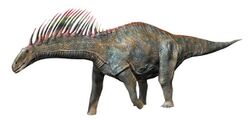Biology:Flagellicaudata
| Flagellicaudata | |
|---|---|

| |
| Restoration of Amargasaurus | |
| Scientific classification | |
| Domain: | Eukaryota |
| Kingdom: | Animalia |
| Phylum: | Chordata |
| Clade: | Dinosauria |
| Clade: | Saurischia |
| Clade: | †Sauropodomorpha |
| Clade: | †Sauropoda |
| Superfamily: | †Diplodocoidea |
| Clade: | †Diplodocimorpha |
| Clade: | †Flagellicaudata Harris & Dodson, 2004 |
| Families | |
Flagellicaudata is a clade of Dinosauria. It belongs to Sauropoda and includes two families, the Dicraeosauridae and the Diplodocidae.[1]
Phylogeny
The clade Flagellicaudata was erected by Harris and Dodson (2004) for the diplodocoid clade formed by Dicraeosauridae and Diplodocidae in their paper describing a new genus of sauropod dinosaur, Suuwassea. The authors carried out a phylogenetic analysis and noted that Suuwassea, although more derived than Rebbachisauridae, is in a trichotomy with other families belonging to Diplodocoidea (Diplodocidae and Dicraeosauridae). Flagellicaudata was defined as a node-based clade consisting of the most recent common ancestor of Dicraeosaurus and Diplodocus and all of its descendants. The word "Flagellicaudata" refers to long, whip-like tails of that animals (flagellum is a Latin word meaning "whip" and cauda means in Latin "tail").[1]
Fragment of cladogram presented in Harris and Dodson, 2004:[1]
| Diplodocoidea |
| ||||||||||||||||||||||||||||||||||||||||||
References
Wikidata ☰ Q2680965 entry

